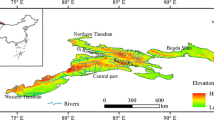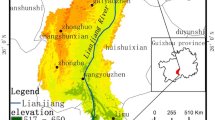Abstract
The eastern Himalayas, especially the Yarlung Zangbo Grand Canyon Nature Reserve (YNR), is a global hotspot of biodiversity because of a wide variety of climatic conditions and elevations ranging from 500 to > 7000 m above sea level (a.s.l.). The mountain ecosystems at different elevations are vulnerable to climate change; however, there has been little research into the patterns of vegetation greening and their response to global warming. The objective of this paper is to examine the pattern of vegetation greening in different altitudinal zones in the YNR and its relationship with vegetation types and climatic factors. Specifically, the inter-annual change of the normalized difference vegetation index (NDVI) and its variation along altitudinal gradient between 1999 and 2013 was investigated using SPOT-VGT NDVI data and ASTER global digital elevation model (GDEM) data. We found that annual NDVI increased by 17.58 % in the YNR from 1999 to 2013, especially in regions dominated by broad-leaved and coniferous forests at lower elevations. The vegetation greening rate decreased significantly as elevation increased, with a threshold elevation of approximately 3000 m. Rising temperature played a dominant role in driving the increase in NDVI, while precipitation has no statistical relationship with changes in NDVI in this region. This study provides useful information to develop an integrated management and conservation plan for climate change adaptation and promote biodiversity conservation in the YNR.





Similar content being viewed by others
References
Bertrand, R., Lenoir, J., Piedallu, C., Riofrio-Dillon, G., Ruffray, P., Vidal, C., Pierrat, J. C., & Gégout, J. C. (2011). Changes in plant community composition lag behind climate warming in lowland forests. Nature, 479, 517–520.
Deng, L., Chen, D., & Dun, L. (2011). Ecological evaluation of Yarlung Zangbo Grand Canyon National Nature Reserve in Tibet. Scientia Silvae Snicae, 47(5), 1–6 (in Chinese with English abstract).
Ding, M., Li, L., Zhang, Y., Sun, X., Liu, L., Gao, J., Wang, Z., & Li, Y. (2015). Start of vegetation growing season on the Tibetan Plateau inferred from multiple methods based on GIMMS and SPOT NDVI data. Journal of Geographical Sciences, 25(2), 131–148.
Ding, M., Zhang, Y., Sun, X., Liu, L., Wang, Z., & Bai, W. (2013). Spatiotemporal variation in alpine grassland phenology in the Qinghai-Tibetan Plateau from 1999 to 2009. Chinese Science Bulletin, 58(3), 396–405.
Djebou, D. C. S., Singh, V. P., & Frauenfeld, O. W. (2015). Vegetation response to precipitation across the aridity gradient of the southwestern United States. Journal of Arid Environments, 115, 35–43.
Dockerty, T., Lovett, A., & Watkinson, A. (2003). Climate change and nature reserves: examining the potential impacts, with examples from Great Britain. Global Environmental Change, 13(2), 125–135.
Fan, J., Li, J., Xia, R., Hu, L., & Li, G. (2014). Assessing the impact of climate change on the habitat distribution of the giant panda in the Qinling Mountains of China. Ecological Modelling, 274, 12–20.
Gessner, U., Naeimi, V., Klein, I., Kuenzer, C., Klein, D., & Dech, S. (2013). The relationship between precipitation anomalies and satellite-derived vegetation activity in Central Asia. Global and Planetary Change, 110, 74–87.
Guyon, D., Guillot, M., Vitasse, Y., Cardot, H., Hagolle, O., Delzon, S., & Wigneron, J. P. (2011). Monitoring elevation variations in leaf phenology of deciduous broadleaf forests from SPOT/VEGETATION time-series. Remote Sensing of Environment, 115(2), 615–627.
Hughes, C., & Eastwood, R. (2006). Island radiation on a continental scale: exceptional rates of plant diversification after uplift of the Andes. Proceedings of the National Academy of Sciences United States of America, 103, 10334–10339.
Lenoir, J., Gégout, J. C., Marquet, P. A., de Ruffray, P., & Brosse, H. (2008). A significant upward shift in plant species optimum elevation during the 20th century. Science, 320, 1768–1771.
Li, B. (1984). The vertical spectra of vegetation in the Namjag Barwa region. Mountain Research, 2(3), 174–181 (in Chinese with English abstract).
Li, H., Li, Y., Shen, W., Li, Y., Lin, J., Lu, X., Xu, X., & Jiang, J. (2015a). Elevation-dependent vegetation greening of the Yarlung Zangbo River basin in the southern Tibetan Plateau, 1999–2013. Remote Sensing, 7(12), 16672–16687.
Li, R., Xu, M., Wong, M. H. G., Qiu, S., Li, X., Ehrenfeld, D., & Li, D. (2015b). Climate change threatens giant panda protection in the 21st century. Biological Conservation, 182, 93–101.
Liu, X., Cheng, Z., Yan, L., & Yin, Z. (2009a). Elevation dependency of recent and future minimum surface air temperature trends in the Tibetan Plateau and its surroundings. Global and Planetary Change, 68, 164–174.
Liu, Y., Zhang, J., & Yang, W. (2009b). Responses of alpine biodiversity to climate change. Biodiversity, 17(1), 88–96 (in Chinese with English abstract).
Lotsch, A., Friedl, M. A., Anderson, B. T., & Tucker, C. J. (2003). Coupled vegetation‐precipitation variability observed from satellite and climate records. Geophysical Research Letters, 30(14), 81–84.
Mann, H. B. (1945). Non-parametric tests against trend. Econometrica, 13, 163–171.
Mohammat, A., Wang, X., Xu, X., Peng, L., Yang, Y., Zhang, X., Myneni, R. B., & Piao, S. (2013). Drought and spring cooling induced recent decrease in vegetation growth in Inner Asia. Agricultural and Forest Meteorology, 178–179, 21–30.
Parmesan, C., & Yohe, G. (2003). A globally coherent fingerprint of climate change impacts across natural systems. Nature, 421, 37–42.
Pearson, R. G., Phillips, S. J., Loranty, M. M., Beck, P. S. A., Damoulas, T., Knight, S. J., & Goetz, S. J. (2013). Shifts in Arctic vegetation and associated feedbacks under climate change. Nature Climate Change, 3, 673–677.
Peng, B. (1986). Some problems of vertical zonation in Mt. Namjagbarwa area. Acta Geographica Sinica, 41(1), 51–58 (in Chinese with English abstract).
Piao, S., Cui, M., Chen, A., Wang, X., Ciais, P., Liu, J., & Tang, Y. (2011a). Altitude and temperature dependence of change in the spring vegetation green-up date from 1982 to 2006 in the Qinghai-Xizang Plateau. Agricultural and Forest Meteorology, 151, 1599–1608.
Piao, S., Mohammat, A., Fang, J., Cai, Q., & Feng, J. (2006). NDVI-based increase in growth of temperate grasslands and its responses to climate changes in China. Global Environmental Change, 16, 340–348.
Piao, S., Wang, X., Ciais, P., Zhu, B., Wang, T., & Liu, J. (2011b). Changes in satellite-derived vegetation growth trend in temperate and boreal Eurasia from 1982 to 2006. Global Change Biology, 17, 3228–3239.
Qin, J., Yang, K., Liang, S., & Guo, X. (2009). The altitudinal dependence of recent rapid warming. Climatic Change, 97, 321–327.
Rangwala, I., & Miller, J. R. (2012). Climate change in mountains: a review of elevation-dependent warming and its possible causes. Climatic Change, 114, 527–547.
Rowe, A. K., Rutledge, S. A., Lang, T. J., Ciesielski, P. E., & Saleeby, Y. S. (2008). Elevation-dependent trends in precipitation observed during NAME. Monthly Weather Review, 136, 4962–4978.
Shen, M., Piao, S., Cong, N., Zhang, G., & Jassens, I. A. (2015). Precipitation impacts on vegetation spring phenology on the Tibetan Plateau. Global Change Biology. doi:10.1111/gcb.12961.
Shen, M., Zhang, G., Cong, N., Wang, S., Kong, W., & Piao, S. (2014). Increasing altitudinal gradient of spring vegetation phenology during the last decade on the Qinghai–Tibetan Plateau. Agricultural and Forest Meteorology, 189–190, 71–80.
Tao, J., Zhang, Y., Dong, J., Fu, Y., Zhu, J., Zhang, G., Jiang, Y., Zhang, X., Zhang, T., & Xi, Y. (2015). Elevation-dependent relationships between climate change and grassland vegetation variation across the Qinghai-Xizang Plateau. International Journal of Climatology, 35, 1638–1647.
Trujillo, E., Molotch, N. P., Goulden, M. L., Kelly, A. E., & Bales, R. C. (2012). Elevation-dependent influence of snow accumulation on forest greening. Nature Geoscience, 5, 705–709.
Walker, J. J., de Beurs, K. M., & Wynne, R. H. (2014). Dryland vegetation phenology across an elevation gradient in Arizona, USA, investigated with fused MODIS and Landsat data. Remote Sensing of Environment, 144, 85–97.
Xue, D., & Jiang, M. (1995). Contributions of nature reserves in China to biodiversity conservation. Journal of Natural Resources, 10(3), 286–291 (in Chinese with English abstract).
Yang, Y., Gao, D., & Li, B. (1995). Research progress and geographical discovery for the largest canyon in world—the expedition to Yarlung Zangbo Grand Canyon’s investigation. Advances in Earth Science, 10(3), 1–9 (in Chinese with English abstract).
Yu, X., Ji, J., Gong, J., Kong, D., Qing, J., Wang, L., Zhong, D., & Zhang, Z. (2011). Evidences of rapid erosion driven by climate in the Yarlung Zangbo (Tsangpo) Great Canyon, the eastern Himalayan syntaxis. Chinese Science Bulletin, 56(11), 1123–1130.
Zhang, Y., Gao, J., Liu, L., Wang, Z., Ding, M., & Yang, X. (2013). NDVI-based vegetation changes and their responses to climate change from 1982 to 2011: a case study in the Koshi River Basin in the middle Himalayas. Global and Planetary Change, 108, 139–148.
Zhang, Y., Liu, F., Wang, X., Zhou, J., Liu, M., Zhang, J., Wang, W., & Li, D. (2014). The impact investigation and adaptation strategy analysis of climate change on nature reserve in China. Acta Ecologica Sinica, 34(2), 106–109.
Acknowledgments
This work was funded by the National Natural Science Foundation of China (Grant No. 41301611 and 41328001), the Natural Science Foundation of Jiangsu Province, China (Grant No. BK20130103 and BK20130568), the State Scholarship Fund of China (Grant No. 201408320065), and the support from Department of Nature and Ecology Conservation, Ministry of Environmental Protection. The authors are grateful to the reviewers for their constructive comments and suggestions for improving the manuscript. We also would like to thank the Flemish Institute for Technological Research (VITO) and China Meteorological Data Sharing Service Network for kindly providing both the NDVI and climate data.
Author information
Authors and Affiliations
Corresponding author
Rights and permissions
About this article
Cite this article
Li, H., Jiang, J., Chen, B. et al. Pattern of NDVI-based vegetation greening along an altitudinal gradient in the eastern Himalayas and its response to global warming. Environ Monit Assess 188, 186 (2016). https://doi.org/10.1007/s10661-016-5196-4
Received:
Accepted:
Published:
DOI: https://doi.org/10.1007/s10661-016-5196-4




